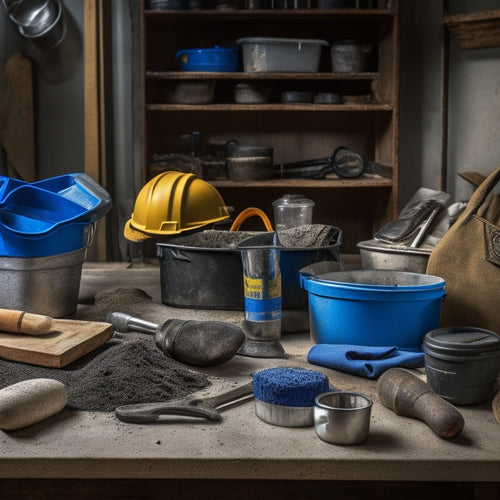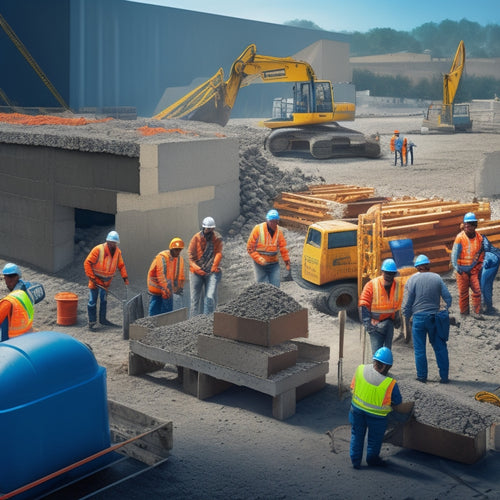
7 Best Tools for Architectural Concrete Installation
Share
You're investing in the right tools to guarantee your architectural concrete installations meet the highest standards of quality and precision, and that's a vital decision that can make all the difference in your project's success. Concrete block lifting devices, precision block cutting saws, and high-torque drill machines will streamline your installation process. Interlocking block spacers will assure uniform joints, while compact vibro-compaction plates will achieve dense, uniform finishes. Leveling and alignment tools will guarantee precise placement, and block handling and clamping systems will facilitate seamless integration of blocks into your design. Now, discover how these tools can work together to elevate your architectural concrete installations.
Key Takeaways
• Concrete handling and placement tools, such as block lifting devices and clamping systems, ensure accurate positioning and minimize block damage.
• Precision cutting and drilling tools, like block cutting saws and high-torque drill machines, guarantee accurate cuts and holes for architectural concrete.
• Installation efficiency tools, including interlocking block spacers and leveling and alignment tools, streamline the installation process and reduce labor costs.
• Compaction and finishing tools, such as compact vibro-compaction plates, deliver high-frequency vibrations for efficient concrete consolidation and dense finishes.
• Investing in quality tools reduces errors, increases productivity, and achieves professional results, enhancing client satisfaction and business success.
Concrete Block Lifting Devices
When preparing for architectural concrete installation, you'll need concrete block lifting devices to efficiently and safely move heavy blocks into place. These devices are designed to distribute the load evenly, guaranteeing that the blocks are lifted and positioned accurately without compromising the structural integrity of the concrete.
A good concrete block lifting device should have robust safety features to prevent accidents and injuries. Look for devices with automatic load-holding valves, which will hold the block in place even if the hydraulic system fails. Additionally, the device should have a sturdy frame that can withstand the weight of the block and any external forces.
Some advanced concrete block lifting devices come equipped with features like adjustable clamping systems, which allow for precise load distribution and reduced risk of block damage. These devices can also be customized to fit specific block sizes and types, making them an essential tool for any architectural concrete installation project.
Precision Block Cutting Saws
When you're working with precision block cutting saws, you can expect accurate cuts every time, thanks to advanced technology that guarantees precision cutting.
You'll also appreciate the dustless cutting technology that keeps your workspace clean and minimizes mess.
Accurate Cuts Guaranteed
With precision block cutting saws, you can rely on making accurate cuts in architectural concrete blocks, guaranteeing a precise fit and minimizing waste. These saws are designed to deliver exceptional measurement accuracy, allowing you to execute complex cutting techniques with confidence.
Whether you're working with intricate designs or precise angles, precision block cutting saws provide the precision you need to achieve professional results.
When it comes to measurement accuracy, these saws are unparalleled. With advanced laser-guided systems and precision-engineered blades, you can trust that your cuts will be exact and reliable.
This level of accuracy not only saves you time and materials but also guarantees that your final product meets the highest standards of quality.
Dustless Cutting Technology
You can greatly reduce airborne dust and debris when cutting architectural concrete blocks by utilizing precision block cutting saws equipped with advanced dustless cutting technology.
This innovative technology employs effective dust control methods, ensuring a cleaner and healthier work environment. By incorporating a vacuum system or water misting feature, these saws minimize the dispersion of dust particles, reducing the risk of respiratory issues and improving overall air quality.
When selecting a precision block cutting saw with dustless cutting technology, consider the type of cutting blade that best suits your project requirements.
Diamond-coated blades, for instance, provide exceptional cutting performance and extended blade life, making them ideal for high-volume concrete cutting applications. Carbide-tipped blades, on the other hand, offer improved durability and resistance to wear, making them suitable for cutting through reinforced concrete.
High-Torque Drill Machines
High-torque drill machines, capable of delivering up to 1,200 inch-pounds of torque, are essential for efficiently drilling large-diameter holes in architectural concrete.
You'll appreciate the high torque benefits these machines provide, such as increased productivity and reduced fatigue. With the ability to drill through thick, hard concrete, you can complete projects quickly and accurately.
When selecting a high-torque drill machine, look for features that enhance performance and durability. A robust motor with a high power-to-weight ratio guarantees consistent torque output, even in demanding applications.
Additionally, a reliable gearbox and transmission system help to minimize wear and tear, reducing maintenance costs over time. Other key drill machine features to take into account include adjustable speed control, ergonomic design, and integrated safety features, such as overload protection and thermal cut-off.
Interlocking Block Spacers
Accurately spacing blocks is critical in architectural concrete installation, and interlocking block spacers guarantee uniform joints and precise alignment. When you use interlocking block spacers, you can ascertain that your blocks are positioned correctly, which is essential for a successful installation.
These spacers offer several benefits, including improved installation efficiency and reduced labor costs. With interlocking block spacers, you can complete projects faster and with greater accuracy, allowing you to take on more complex and ambitious projects.
One of the key interlocking spacer benefits is that they enable you to achieve consistent joint spacing, which is critical for the structural integrity of your installation. By ascertaining that joints are consistently spaced, you can reduce the risk of cracks and other defects.
Additionally, interlocking block spacers are designed to be reusable, making them a cost-effective solution for your installation projects. By incorporating interlocking block spacers into your workflow, you can streamline your installation process, reduce errors, and achieve professional-looking results.
Compact Vibro-Compaction Plates
Compact vibro-compaction plates deliver powerful, high-frequency vibrations that efficiently consolidate freshly poured concrete, ensuring a dense, uniform finish. These plates are designed to optimize vibratory plate performance, making them an essential tool for architectural concrete installation.
As you work with compact vibro-compaction plates, you'll appreciate their compact design benefits, which enable you to access tight spaces and navigate complex project layouts with ease.
The high-frequency vibrations generated by these plates facilitate rapid consolidation of concrete, reducing the risk of air pockets and imperfections. This results in a stronger, more durable concrete structure that can withstand the test of time.
Additionally, compact vibro-compaction plates are built to withstand the rigors of heavy-duty use, ensuring consistent performance even in demanding project environments.
Leveling and Alignment Tools
You'll need to guarantee precise leveling and alignment of freshly poured concrete to achieve the desired architectural finish, and that's where specialized leveling and alignment tools come into play.
To ascertain accurate results, you'll want to invest in high-quality tools that can withstand the demands of concrete installation. For laser leveling, consider using self-leveling lasers that provide precise and accurate readings, allowing you to adjust the concrete pour accordingly. These tools are ideal for large-scale projects where accuracy is paramount.
In addition to laser leveling, you'll also need to employ advanced alignment techniques to ascertain the concrete is poured to the correct specifications. This may involve using string lines, screeds, or other specialized tools to guide the pour.
Block Handling and Clamping Systems
When working with architectural concrete blocks, efficient handling and clamping systems are essential to guarantee precise placement and secure holding during the installation process. You need a reliable system to transport and position blocks accurately, ensuring a seamless installation. A well-designed block handling system allows you to move blocks safely and efficiently, reducing the risk of damage or injury.
Look for systems that incorporate safety equipment, such as gloves and harnesses, to protect you and your team during transport and placement.
A good clamping system is equally important, providing the necessary holding power to keep blocks in place while you work. You'll want clamps that can apply even pressure, ensuring a secure hold without damaging the blocks. Consider clamps with adjustable pressure settings to accommodate varying block sizes and weights.
When choosing a block handling and clamping system, prioritize durability, versatility, and ease of use. By investing in the right tools, you'll streamline your installation process, reduce errors, and achieve professional results.
With the right system, you'll be able to focus on creating stunning architectural concrete installations that meet your clients' expectations.
Frequently Asked Questions
What Safety Gear Is Necessary for Concrete Installation Workers?
When working with concrete, you must prioritize your safety above all else. Familiarize yourself with the latest safety regulations to guarantee you're taking the necessary precautions.
Wear protective equipment such as steel-toed boots, hard hats, and safety glasses to prevent injuries. Don't forget gloves, respirators, and earplugs to safeguard against skin contact, airborne particles, and loud machinery.
Can I Rent These Tools or Must I Purchase Them?
As you finalize your concrete installation plans, you're likely wondering if you need to break the bank on tools. Coincidentally, you have options.
You can rent specialized tools, like screeds and trowels, for a fraction of the cost. Alternatively, purchasing options are available for frequent users or those seeking long-term investments.
Weigh the costs and benefits before deciding which route is best for your project's unique needs and your budget.
How Do I Maintain and Store Tools When Not in Use?
When you're not using your tools, proper maintenance and storage are essential to extend their lifespan and guarantee peak performance.
You should prioritize tool cleaning, wiping down each item with a soft cloth and mild detergent to prevent corrosion.
Next, focus on tool organization, categorizing and storing items in a dry, protected area. This will prevent damage, reduce rust, and make it easier to find what you need when you need it.
Are There Any Specific Certifications for Operating These Tools?
As you wield the mighty tools of your trade, remember the wisdom of Hephaestus, the Greek god of craftsmanship, who knew that skill without certification is like a hammer without a handle.
When it comes to operating specialized equipment, you'll want to verify you have the right certification programs under your belt.
Look for tool operator qualifications that validate your expertise, such as OSHA or ACI certifications, to prove your mettle and guarantee a job well done.
What Is the Average Cost of These Tools for a Small Project?
When planning a small project, you'll want to allocate a significant portion of your budget for the right tools.
The average cost of specialized tools, such as tamping machines, finishing tools, and molds, can range from $5,000 to $20,000.
Considering the variety of tool types you'll need, it's crucial to prioritize your project budget.
You may need to compromise on quality or quantity to stay within budget, so carefully assess your needs and make informed decisions.
Conclusion
As you lay the final block, the structure rises like a phoenix from the dust, a proof of your mastery of architectural concrete installation.
With these 7 tools in your arsenal, the foundation of your craft is solid, unshakeable.
You've built more than just walls – you've constructed a work of art that stands the test of time, a symphony of concrete and steel that echoes with precision and perfection.
Related Posts
-

5 Tools Needed for Quick Fix Concrete Mixing
You'll need five essential tools to tackle a quick fix concrete mixing project efficiently. First, you'll require a s...
-

Essential Tools for Epoxy Concrete Floor Repair
You'll need a thorough arsenal of specialized tools to guarantee a successful epoxy concrete floor repair. Floor prep...
-

7 Best Tools for Concrete Block Construction
You'll need a solid foundation, precise cutting, and seamless finishing to guarantee your concrete block construction...


